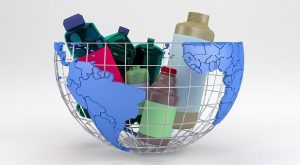“Recycling, Bioplastics, and Alternatives”
.
We need to deal with plastic pollution – and there are innovative ideas out there:
The circular economy as a solution to plastic waste – Vision Group for Sidmouth
.
One of the most common plastics in consumer goods is PET – and its recycled version is becoming very popular:
Recycled PET (rPET ) can be used to make many new products, including new plastic bottles, clothing, fibrefill, industrial strapping, sheet and film and automotive parts. As a result, there is a strong demand for recovered PET, and domestic demand for food-grade recycled plastics currently outstrips domestic supply.
.
Clean Tech operates the UK’s largest bottle recycling plant ( part of Plastipak) and is the UK’s leading producer of food-grade recycled PET (rPET). Information about it appears about halfway down this page:
Fulfilling our Sustainability Goals Through Clean Tech
.
In the developing world, there is an innovative company at work:
Plastic Bank sets up recycling ecosystems in countries that lack sufficient disposal infrastructure and have high rates of pollution and poverty. We set up collection locations and employ citizens of those regions to manage these ecosystems. Residents in those regions can collect plastic from their environment and bring it to their local Plastic Bank branch in exchange for money, fresh food, clean water, cellular service, cooking oil, or even school tuition for their children. Collectors are paid a Social Plastic premium in addition to the market plastic value, which ensures a stable, liveable income.
Frequently Asked Questions – Plastic Bank
.
But is rPET really a ‘good thing’?
The international fashion industry network FashionUnited looks at the pros and cons in a piece from 2018:
.
How sustainable is recycled polyester?
Nearly half of the world’s clothing is made of polyester and Greenpeace forecasts this amount to nearly double by 2030. Why? The athleisure trend if one of the main reasons behind it: an increasing number of consumers are look for stretchier, more resistant garments. The problem is, polyester is not a sustainable textile option, as it is made from polyethylene terephthalate (PET), the most common type of plastic in the world. In short, the majority of our clothes come from crude oil, while the Intergovernmental Panel on Climate Change (IPCC) is calling for drastic actions to keep the world’s temperature to a maximum of 1.5 °C above pre-industrial levels.
One year ago, the non-profit organization Textile Exchange challenged over 50 textile, apparel and retail companies (including giants like Adidas, H&M, Gap and Ikea) to increase their use of recycled polyester by 25 percent by 2020. It worked: last month, the organization issued a statement celebrating that signatories have not only met the goal two years before the deadline, they have actually exceeded it by upping their use of recycled polyester by 36 percent. In addition, twelve more companies have pledged to join the challenge this year. The organization forecasts 20 percent of all polyester to be recycled by 2030.
Recycled polyester, also known as rPET, is obtained by melting down existing plastic and re-spinning it into new polyester fiber. While much attention is given to rPET made from plastic bottles and containers thrown away by consumers, in reality polyethylene terephthalate can be recycled from both post-industrial and post-consumer input materials. But, just to give an example, five soda bottles yield enough fiber for one extra large T-shirt.
Although recycling plastic sounds like an indisputable good idea, rPET’s celebration is far from being a unanimity in the sustainable fashion community. FashionUnited has gathered the main arguments from both sides.
…
How sustainable is recycled polyester?
.
This has been a question which has vexed the fashion industry for some time now:
How sustainable is recycled plastic, really? – Vogue Australia
.
As covered in a recent post here:
How to greenwash fashion – and how to spot it – Vision Group for Sidmouth
.
 But the concerns go much wider.
But the concerns go much wider.
It’s very difficult and very expensive to recycle most plastics:
The truth about recycling plastic – Mitte
Especially at a practical level – even in the most developed of courntries:
The ugly truth about recycling in the US: it’s garbage
And yet biodegradable plastics are not necessarily the solution:
Biodegradable vs. Recyclable Plastics: What’s Better for the Environment? – Custom-Pak, Inc.
.
Nevertheless, there is a real push happening, as with this report just out – taking us back to the importance of the circular economy:
.
Sustainable Plastics Will Make up More Than 15% of Production by 2030
Future projections of a circular economy emphasize that a combination of recycled and bio-based resources will serve as a feedstock for plastic needs. However, in order for that idealistic future to be realized, there must be a major investment in new technologies, including advanced recycling tech and bio-based plastic capacity. In its new report, “The Sustainable Plastics Roadmap: Recycling, Bioplastics, and Alternatives,” Lux Research forecasts the adoption of conventional and advanced recycling, bio-based plastics, and alternative materials and quantifies the impact of bans and other regulations to predict the future of sustainable plastics.
Single-use plastics are particularly in the crosshairs with consumers and regulators, and companies across a wide range of industries are trying to deploy sustainable solutions. Both companies that produce plastics and those that use them in their products need to understand the outlook for sustainable plastics and alternatives in order to prepare their strategy.
Sustainable Plastics Will Make up More Than 15% of Production by 2030
.
image: 500+ Free Recycling & Recycle Illustrations – Pixabay